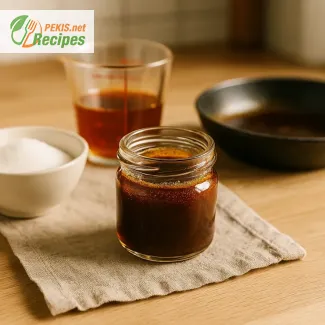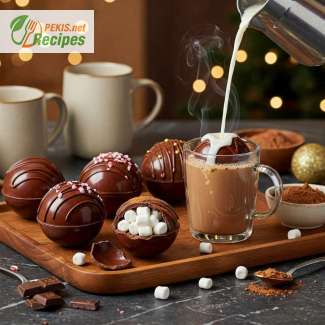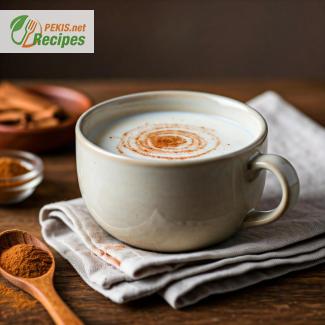
Soothing Homemade Syrup with Caramelized Sugar
Discover the time-tested cough remedy made from just two ingredients
When the colder months arrive and dry coughs or scratchy throats become a frequent nuisance, people often turn to natural, time-honored remedies passed down through generations. Among these, the burnt sugar cough remedy stands out as a remarkably simple yet effective solution that brings relief with both comfort and flavor. Rooted in traditional home medicine, this method uses caramelized sugar as its base to create a syrup that coats the throat and eases irritation—making it especially beloved by children and adults alike.
Unlike commercial syrups filled with artificial additives and preservatives, this homemade cough syrup is created with just a few ingredients you already have in your kitchen. It’s quick to prepare, soothing on the throat, and often described as a warm, nostalgic taste of childhood—like a liquid version of a toasted caramel candy. The sweetness of the caramelized sugar not only makes it more palatable for younger ones, but it also provides a gentle, soothing layer that can help reduce coughing fits and ease nighttime restlessness due to throat tickles.
The remedy is especially popular in Eastern European households, where grandmothers still swear by its simplicity and effectiveness. In recent years, it has gained global recognition as people seek natural, minimal-ingredient solutions that avoid over-the-counter medications whenever possible. This preparation is an ideal choice for anyone looking for a gentle, drug-free remedy to manage light coughs caused by seasonal allergies, dry indoor heating, or lingering sore throat after a cold.
What makes this burnt sugar syrup so uniquely effective is the way sugar transforms under high heat. As it caramelizes, sugar develops complex flavors and slightly thickens. Once combined with water or milk, it creates a silky mixture that soothes the mucous membranes. Some people even enhance its properties with additions like butter, milk, or lemon juice, but at its core, the burnt sugar syrup remains delightfully simple.
This remedy is particularly useful in the evening when dry coughs tend to worsen. A spoonful of warm syrup before bed can help coat the throat and reduce the urge to cough through the night, leading to more restful sleep. It is also an excellent option for those who avoid alcohol or other chemical-based syrups, as this version contains no alcohol, no preservatives, and can be customized to personal taste or dietary needs.
As interest in natural home remedies continues to grow, this traditional solution is enjoying a well-deserved resurgence. Whether you're looking for a natural solution for your child, a soothing treat for yourself, or simply want to explore remedies that have stood the test of time, the burnt sugar cough remedy is a comforting, effective option that brings more than just relief—it brings a taste of tradition, warmth, and care.
In the sections that follow, we’ll guide you through the exact ingredients, the step-by-step method, and offer helpful tips on how to adjust the recipe for different preferences or dietary restrictions. You’ll also learn how to store it, how long it keeps, and how to incorporate it into your daily routine during the colder months. Whether you're preparing it for the first time or revisiting a childhood favorite, this timeless recipe is sure to become a trusted addition to your natural remedy collection.
- Place a small saucepan or a non-stick skillet over medium heat.
- Add the white sugar to the dry pan and allow it to melt slowly without stirring. Gently swirl the pan if needed to help it melt evenly.
- As the sugar starts to melt, it will turn golden, then amber. Continue heating until it reaches a rich, deep caramel color. Be careful not to burn it—dark brown is fine, black is not.
- Once the desired caramelization is reached, carefully pour in the water. The mixture will steam and bubble vigorously—step back and stir with a heat-resistant spoon until smooth.
- Reduce heat to low and stir continuously until the syrup is completely dissolved and smooth.
- Remove from heat and let the syrup cool for 10–15 minutes.
- Transfer into a sterilized glass jar or bottle. The syrup will thicken slightly as it cools.
Serving suggestion: Take 1 tablespoon (15 ml) up to 3 times per day as needed for cough relief. Ideal before bedtime to soothe dry throat irritation.
Creative Ways to Upgrade Your Burnt Sugar Syrup Remedy
Enhance the taste, texture, and health benefits of this classic homemade solution
The beauty of traditional recipes lies in their simplicity and authenticity, and the burnt sugar cough syrup is no exception. With just sugar and water, this preparation captures the essence of natural home care. But while it remains effective in its basic form, there are several thoughtful ways to elevate its flavor, texture, and therapeutic effects without sacrificing its nostalgic charm. Through minor adjustments and smart additions, this humble syrup can become a more pleasant, functional, and versatile remedy for soothing sore throats and calming dry coughs.
Adding richness with dairy or plant-based milk
One of the most popular improvements is replacing plain water with milk or plant-based alternatives like oat milk or almond milk. This transforms the syrup into a creamier, more luxurious version that’s easier on the throat and delivers a comforting, almost dessert-like experience. The fat in milk helps to coat the throat more effectively, prolonging the soothing effect. Plant-based milks also offer a dairy-free option, suitable for those with lactose intolerance or dietary restrictions, and often contain added vitamins such as B12 and D.
Using full-fat milk results in a velvety consistency and richer flavor, while oat milk adds a natural sweetness and nuttiness that complements the caramel tones of burnt sugar. If opting for milk, ensure the syrup is consumed fresh and stored in the refrigerator, as the addition shortens its shelf life.
Boosting therapeutic benefits with honey and herbs
Adding raw honey once the syrup has cooled enhances its antibacterial and anti-inflammatory properties, making it even more effective for treating sore throats. Honey has long been used in natural medicine, and its combination with burnt sugar syrup is both traditional and well-loved.
For additional medicinal benefits, consider infusing the syrup with soothing herbs like thyme, sage, or ginger. Simply steep the herbs in warm water, strain, and then use this herbal infusion in place of plain water during preparation. These herbs add layers of complexity to the taste while boosting the syrup's immune-supporting qualities.
Flavor variations for better taste and appeal
Though the base recipe has a deep, bittersweet profile, you can play with ingredients to make it more palatable, especially for children. Adding a drop of vanilla extract or a pinch of cinnamon softens the sharp caramel flavor and introduces warmth and roundness. A splash of lemon juice not only adds brightness but also provides a natural dose of vitamin C, supporting the immune system.
Another creative twist is to incorporate a small amount of clove or star anise during the cooking process. These spices have natural expectorant and antiseptic properties and lend an exotic, aromatic note that makes the syrup more enjoyable.
Common mistakes to avoid when making burnt sugar syrup
While the recipe may appear simple, there are critical steps that determine the success of the syrup:
- Overheating the sugar: Sugar can go from golden to burnt in seconds. Watch closely and remove it from the heat when it reaches a deep amber color, not black. Burnt sugar that's too dark will taste bitter and may irritate rather than soothe the throat.
- Adding cold water too quickly: Pouring cold water into hot caramel can cause it to harden immediately or splatter. Use warm or room-temperature water and add it slowly and carefully to prevent burns or crystallization.
- Undercooking or overcooking: If the sugar hasn’t fully caramelized, the resulting syrup may be overly sweet and lack the desired depth. If overcooked, it can develop a burnt taste or sticky texture that hardens on cooling.
Why homemade is better than store-bought
A homemade remedy gives you complete control over the ingredients, ensuring there are no artificial colors, preservatives, or unwanted additives. Unlike commercial syrups, this version contains no alcohol, no thickeners, and can be adapted to dietary preferences. Moreover, it carries the comfort of tradition, often passed down through generations and associated with the care of a parent or grandparent.
Making it at home also allows for customization. Whether you need it vegan, low in sugar, or infused with specific herbs, this remedy can be tailored to suit your exact needs without compromising on taste or effectiveness.
Health-conscious substitutions for better wellness
To create a healthier version of the classic, consider using coconut sugar or raw cane sugar instead of refined white sugar. These alternatives have a lower glycemic index and retain trace minerals like potassium and magnesium. Keep in mind, however, that they caramelize differently and may affect the final flavor and consistency.
If reducing sugar intake is a priority, you can dilute the syrup with more water or milk, or use it only when absolutely needed rather than on a regular basis. Avoid using artificial sweeteners, as they do not caramelize and may not provide the soothing texture needed for throat relief.
When and how to use the improved versions
These upgraded versions are not only more appealing in taste but also extend the utility of the syrup. The creamier, honey-infused or herb-enriched versions can be enjoyed as:
- A warm drink mixed with herbal tea
- A drizzle over oatmeal or yogurt for a therapeutic breakfast
- A spoonful before bed to reduce nighttime coughing
- A base for a comforting warm milk beverage
Improving the burnt sugar syrup recipe is less about changing tradition and more about enhancing what already works. Whether you choose to add honey, milk, herbs, or just adjust the cooking method, these refinements transform the classic into something even more delightful, effective, and versatile. Most importantly, they keep the spirit of home remedies alive—personal, simple, and filled with care.
- This recipe is gluten-free and free of common allergens like dairy, eggs, nuts, soy, and shellfish.
Suggestions to avoid allergens and gluten:
- No substitutions necessary, but ensure that the sugar used is pure and unprocessed to avoid hidden cross-contamination in extremely sensitive individuals.
- Calcium: 0.4 mg – supports bone strength, minimal in this recipe
- Potassium: 0.2 mg – helps regulate fluid balance, trace amount
- Magnesium: 0.1 mg – contributes to nerve function, negligible
- Iron: 0.02 mg – supports oxygen transport, negligible
- Burnt sugar contains small traces of melanoidins, which are antioxidant compounds formed during the caramelization process.
- Approximate antioxidant value per tablespoon: 0.2 µmol TE (Trolox Equivalent) – may offer mild protection against oxidative stress but not significant as a dietary source.





